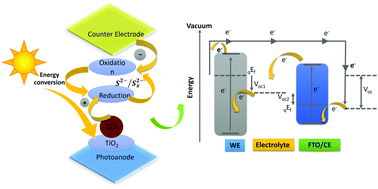Recent progress in quantum dot sensitized solar cells: an inclusive review of photoanode, sensitizer, electrolyte, and the counter electrode
Abstract
The increasing energy demands and global population together with concerns over global warming are driving the search and development of clean and renewable energy sources such as solar cells, fuel cells, batteries, and supercapacitors; in the last few decades, quantum dot-sensitized solar cells (QDSCs) have attracted significant interest because of their perceived benefits over some alternative solar cells in terms of high light, thermal, and moisture stability; tunable absorption range; high absorption coefficient; multiple exciton generation possibility; solution processability, as well as their facile fabrication and low-cost availability. Compared to molecular dyes, quantum dots (QDs) have several advantages, which have exhibited higher molar extinction coefficients and a tunable photoresponse, resulting in a dramatic increase in the power conversion efficiency (PCE) from 5% to 13%. This review article presents a comprehensive overview of the development of QDSCs, including the photoanodes, sensitizers, electrolytes, and counter electrodes (CEs), and discusses future prospects for the development of highly efficient and stable QDSCs.

- This article is part of the themed collection: Recent Review Articles


 Please wait while we load your content...
Please wait while we load your content...